Amy Myers's Blog, page 58
May 3, 2018
12 Essential Swaps for Autoimmune-Friendly Cooking
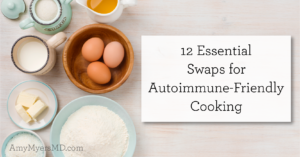
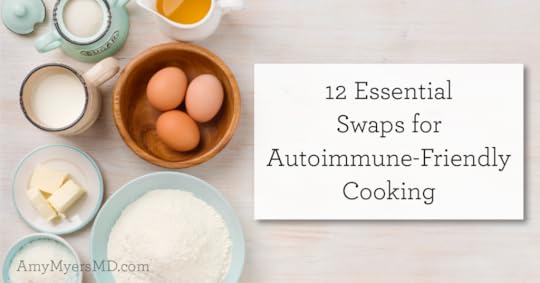
If you have an autoimmune disorder–whether it’s Graves’ disease, lupus, Hashimoto’s, Sjogren’s, rheumatoid arthritis, or one of the hundreds of other autoimmune diseases out there–getting on board with The Myers Way® and autoimmune-friendly cooking is one of the best ways you can take control of your health. By eating the right foods (and ditching the toxic and inflammatory ones) you will begin to see your symptoms melt away. Your headaches, rashes, digestive issues, hair loss, and joint pain will become a distant memory as you learn to cook the foods that support your immune system and reduce the systemic inflammation behind your condition.
One of the biggest hurdles I see in my patients looking to optimize their diets is figuring out how to swap out some of their favorite or most-used foods for autoimmune-friendly versions. The good news is that these days, following an AIP lifestyle is easier than ever, thanks to the many stores and online companies who now offer so much in the way of autoimmune-friendly ingredients, staples, and ready-made snacks. My new cookbook, The Autoimmune Solution Cookbook, also helps take the guesswork out of AIP cooking and guides you step by step on your path towards wellness. (Haven’t ordered your copy yet? Get it here!)
The truth is, you can get pretty creative when swapping autoimmune-friendly foods in place of conventional ones! To help you get started, I’ve compiled this list of essential AIP swaps to make autoimmune-friendly cooking and baking a breeze!
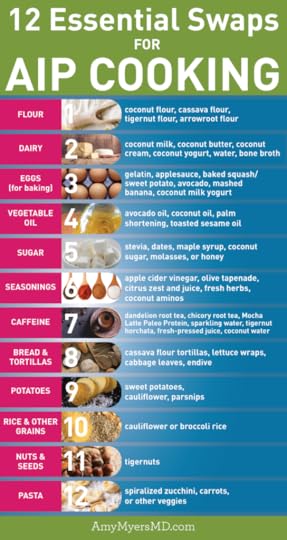
1. Flour
Flour is at the base of so many products, yet most flour you can buy is overly-refined and chock full of gluten. When I wrote The Autoimmune Solution, finding a gluten-free, grain-free flour was very difficult. Nowadays, with the skyrocketing rates of autoimmunity and the simultaneous grassroots wellness movement, more and more AIP products have been popping up on store shelves, including a variety of flours! Coconut flour has become especially popular and you can find this almost anywhere. Some of my other autoimmune-friendly favorites are cassava flour, tigernut flour, and . These might be a little trickier to find at your typical grocery store, however online companies such as Thrive Market and Amazon are great for buying AIP pantry staples.
Both tigernut flour and arrowroot flour are featured in my scrumptious Tigernut Waffles, which is one of the many delicious, autoimmune-friendly breakfast recipes from my new cookbook!
2. Dairy
One of the two most inflammatory foods (second only to gluten), dairy has no place in an autoimmune-friendly diet. Fortunately, there are a number of easy swaps you can make to replace the dairy in your recipes. Use coconut milk, , , and yogurt in place of cow’s milk versions. When buying coconut milk, it’s important to always choose 100% organic, full-fat coconut milk made with only coconut meat and water to avoid inflammatory additives and thickeners.
Coconut oil is another option for replacing butter in cooking and baking. Depending on the recipe, you can also swap milk with water or even bone broth. If you can find it, tigernut milk is another great non-dairy choice.
3. Eggs (for baking)
Eggs offer structure and stability to pastries, muffins, and brownies, so baking without them can take some getting used to. However, there are many unexpected AIP ingredients that can take the place of eggs. One of my favorite egg replacers for baked goods is gelatin. Gelatin has a gel-like quality that serves as a binder in baked goods, plus it comes packed with all the amino acids and other benefits of collagen, which is a vital protein for maintaining a healthy intestinal barrier and supporting healthy bones and joints.
Other potential swaps for eggs in baking include unsweetened applesauce, baked and mashed squash or sweet potato, avocado, mashed banana, and coconut milk yogurt.
4. Vegetable Oil
In addition to being made from foods on The Myers Way® absolute “no” list, vegetable oils including canola, soybean, corn, and safflower are highly processed and full of inflammatory Omega 6s. Instead, opt for high-smoke point , or MCT-rich for your AIP baking and cooking needs. is another vegetable oil alternative for use in baked goods, while lends a mild, nutty flavor to sauces and Asian-inspired dishes.
5. Sugar
Although you’ll want to avoid all sugar during the first 30 days of The Myers Way® or any autoimmune protocol, once your health is restored, many people find that they can enjoy small amounts here and there if you know the right types to choose. In place of refined table sugar, opt for more natural options such as , dates, , , , or . Just remember to keep sweet treats to a minimum, or save them for special occasions.
6. Seasonings
Spices such as paprika, cayenne, and chili powder can cause immune flare-ups in people who are sensitive to nightshades, and soy sauce, which is found in countless recipes, actually contains both soy and gluten. Fortunately, there are plenty of naturally AIP seasonings you can use to add flavor and spice to your dishes. A few of my favorites are , olive tapenade, citrus zest and juice, and fresh herbs. Swap out soy sauce for in stir-fries and marinades!
7. Caffeine
It can be challenging to ditch caffeine, especially if you’ve depended on it for years. Luckily, there are many caffeine-free beverages you can drink to give you that same boost of energy! Herbal tea can easily be exchanged for green or black varieties. with its deep, smoky notes makes a terrific coffee replacement, as does . And if you really just love the taste of coffee and can’t imagine your mornings without it, try my Mocha Latte Paleo Protein powder! Blended with a little non-dairy milk and a few ice cubes, it tastes JUST like a frothy mocha latte without all the inflammatory ingredients!
Beyond the coffee and tea world, sparkling water, tigernut horchata, fresh-pressed juice, and coconut water are all energizing drinks that come without the toxic effects of caffeine.
8. Bread & Tortillas
Grains and gluten are bad news for your gut. However, a lot of gluten-free bread is filled with processed junk and so many artificial ingredients that it’s really not much better for you than eating “regular” bread. If you can’t see yourself abstaining from sandwiches and tacos for good then give the following AIP swaps a try. Cassava flour tortillas are an excellent swap for corn and flour varieties. Meanwhile, lettuce wraps, cabbage leaves, and endive can all be used in place of bread or buns for your favorite burgers and wraps.
9. Potatoes
Potatoes are a ubiquitous comfort food in the standard American diet. If you’re used to eating white potatoes as a staple of your meals, don’t worry! There are plenty of other veggies that can fill that role surprisingly well. Of course, sweet potatoes can be used in any recipe that calls for white potatoes. Steamed and pureed cauliflower or parsnips are a great substitute for mashed potatoes, especially when blended with a bit of ! Rather than snacking on potato chips, try , , cassava chips, or . Your gut will thank you!
10. Rice and Other Grains
For a simple replacement for rice or other grains, I love cauliflower rice! Many retailers now carry prepared cauliflower (or even broccoli!) rice, however it is super easy to make yourself at home as well. Just throw florets in your food processor and pulse until the cauliflower reaches a rice-like consistency, then cook up in whatever recipe you’re making. You can also rice cauliflower on a box grater if you don’t have a food processor.
The mild flavor of cauliflower makes it perfectly adaptable for use in countless recipes, including my Chicken Burrito Bowl and my Vegetable Fried “Rice,” both of which are featured in The Autoimmune Solution Cookbook!
11. Nuts & Seeds
Nuts and seeds are a tricky category because there aren’t too many autoimmune-friendly foods with that nutty crunch and texture. That’s why I was so excited to discover , which are actually little tubers. Tigernuts are full of healthy fats and prebiotic fiber, and according to a recent study by Oxford University, they were shown to have played a critical role in the development of pre-humans to humans, making them the perfect Paleo snack!
12. Pasta
Substitute refined, glutenous, nutrient-poor pasta with spiralized veggie noodles! One of the best pasta replacers is zucchini, which is packed with vitamins A and C, plus potassium and fiber. Carrot and sweet potato make excellent noodles as well. You can buy your own spiralizer, though many stores now sell pre-spiralized veggies for when you need a quick and easy dinner. You’d be surprised how much zucchini noodles (or “zoodles”) taste like spaghetti! They also make a great addition to other noodle dishes such as my Quick and Easy Instant Pot Zoodle Pho!
Once you’ve learned the ins and outs of AIP cooking, making all of your favorite dishes with autoimmune-friendly ingredients will be a snap! And you can feel good knowing your food is helping to relieve your symptoms, provide you with bountiful energy, and setting you on the path to optimal health!
The post 12 Essential Swaps for Autoimmune-Friendly Cooking appeared first on Amy Myers MD.
April 30, 2018
Gluten-Free & AIP Tigernut Waffles
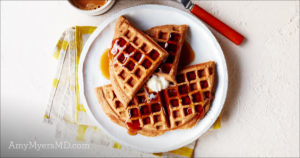
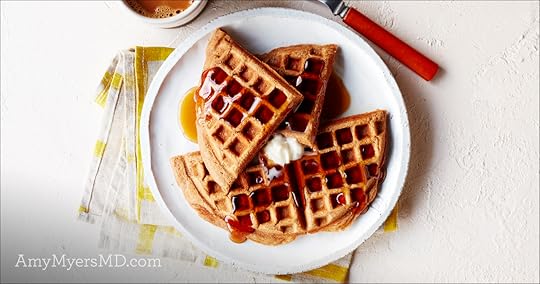
If you thought that your waffle-making days were history, then I’ve got good news for you! Grain-free tigernut flour means you can once again have crisp, homemade waffles. These Tigernut Waffles, featured in The Autoimmune Solution Cookbook, make the perfect AIP brunch!
You’ll want to mix the batter in a food processor or blender to puree the plantain. And if you’re in the market for a new waffle iron, be sure to look for one that has a ceramic coating, rather than Teflon, to avoid harmful chemicals.
For a sweet finish, drizzle with a little maple syrup or raw honey!
Gluten-Free & AIP Tigernut Waffles
CourseBreakfast, Dessert, Snack
ProtocolAutoimmune Solution (AIP), Elimination Diet, Paleo
Servings2 waffles
Ingredients
2tbsp
coconut oil
3/4cup
tigernut flour
1/4cup
arrowroot flour
1/3
green plantain
1/2tsp
fine sea salt
1/2tsp
cream of tartar
1/4tsp
baking soda
1tsp
ground cinnamon
1tbsp
maple syrup
1tbsp
pure vanilla extract
1/2cup
filtered water
Instructions
Lightly oil a waffle iron with 1 tablespoon coconut oil, then heat according to the manufacturer’s directions.
Combine all the ingredients and the remaining 1 tablespoon oil in a food processor or blender. Process until combined. While running the food processor, slowly pour in up to 1⁄2 cup water through the feed tube until the mixture forms the consistency of thick batter.
Pour about 1⁄2 cup batter onto the iron. Close the iron and cook until the waffle is done (it should be golden brown). When the first waffle is done, place on a warm platter and continue with the remaining batter.
The post Gluten-Free & AIP Tigernut Waffles appeared first on Amy Myers MD.
April 29, 2018
6 Tips for Getting Your Family on Board with AIP


This article is a modified excerpt from The Autoimmune Solution Cookbook. It releases May 8th and when you pre-order now you’ll receive $300 in free bonus resources!
If you’ve adopted or are transitioning to The Myers Way® Autoimmune Solution Protocol or another autoimmune protocol (AIP)–whether you’ve recently been diagnosed with an autoimmune disease or have been dealing with one for years–congratulations! You’re on the right path. Optimizing your diet is one of the best steps you can take to reverse your condition and set yourself up for a life of vibrant health. One question I get asked all the time by my patients who are making the switch is how to get your family on board with an AIP lifestyle.
Most of you reading this are probably women, and many of you are moms, since women are three times more likely than men to develop autoimmune conditions, and those conditions often develop during or after pregnancy. As women and mothers, you are probably used to putting everyone else first—your children, your partner, your parents. You may be used to showing your love for your family by preparing comfort foods to brighten their days, baking rich desserts to celebrate special occasions, and indulging their tastes for not-so-healthful meals (pizza night anyone?). The thought that these beloved rituals may change when adopting an AIP lifestyle could be worrisome to your or your loved ones. Or, your family may be reluctant to change their habits, period–after all, they’ve been eating these foods for years. This can lead to turmoil at the dinner table, or worse, it can cause you to prepare TWO meals every night, one AIP version for you, and one “regular” meal for your partner and children.
I’m a mom, wife, physician, and business owner, so I get it! However, and I want you to really internalize this: this is the moment when you need to put yourself first. The very best way for you to be there for your family is if you are healthy, happy, and whole. By committing to your health, you are truly supporting everyone. And the easiest way to maintain that commitment is to get your whole family on board with a lifestyle that will support your health. It’s all about finding a balance, and though it may take some getting used to–and learning how to make your family’s favorites a bit differently–you can keep a well-fed and happy family, while also supporting your health (and theirs!).
Why It’s a Way of Life
The first thing to understand is that I call my program “The Myers Way®” because the Autoimmune Solution Protocol is not simply a diet. It’s a way of life. This is a vital distinction, because autoimmunity impacts our short-term and long-term well-being. It is not a weight-loss program where a cheat day is okay because the consequence is an extra lingering pound or two. Once you identify the symptoms of autoimmunity, finding the root cause and living the solution is vital for moving to the healthy end of the autoimmune spectrum and staying there.
Getting Your Family to Appreciate Nourishing Foods
I was very lucky because I was raised from day one eating real whole foods. We shopped at the local natural foods store (before there was a Whole Foods), had a garden, grew sprouts, and made our own yogurt. My dad taught me how to cook, and my mom taught me how to bake. I learned how to be involved with the food that I put in my body and understood that it was meant to nourish me. I dedicated The Autoimmune Solution Cookbook to my parents because they instilled in me the importance of a nourishing diet and real whole foods.
Although it turned out that the type of food I was eating (a vegetarian diet of grains, legumes, and dairy) wasn’t good for me because of my predisposition toward autoimmunity, I will always be grateful to my parents for teaching me how to be involved with my food.
Even if you, your partner, or your children didn’t grow up this way, now is the perfect time to start! Explain to your family that you will be changing the way you eat by enjoying delicious, real foods with the power to nourish everyone’s bodies and improve their health. Rather than thinking of this as asking your family to give up certain foods, think about it in terms of the health benefits they’ll be gaining!
Women often tell me that their partners lose weight, think more clearly, and have more energy, and that their children are more focused in school, have fewer emotional outbursts, and their behavioral issues vanish—all by switching to The Myers Way® or an AIP or Paleo protocol.
You want the very best for your children, and making eating for optimal health a way of life while they’re young is much easier than trying to make the switch when they’re in their teens or twenties. Again, this is something I will always be grateful for with my own parents because once I finally figured out what diet worked best for reversing autoimmunity, I wasn’t switching abruptly from junk foods to broccoli; I was still eating broccoli and simply swapping out whole grains for lean, organic, grass-fed meats.
And now I have the joy of instilling that same appreciation for nourishing foods in my own daughter! Rather than rice cereal, cow’s milk, and gluten, Elle drinks camel’s milk and eats grass-fed, pasture-raised meats, and organic vegetables and fruits. She doesn’t have an autoimmune disorder, and by eating this way, I hope she never will. Elle is thriving, and we eat The Myers Way® meals together every night as a family, enjoying many of the recipes in The Autoimmune Solution Cookbook.
Remember, The Myers Way® isn’t about deprivation—you will be enjoying delicious, flavorful foods that will keep you energized and full. Though it may take some time to adjust, just remember: you, your partner, and your children were designed to thrive on real, whole foods, and you’re making a powerful investment in their health, as well as yours.
You, your partner, and your children were designed to thrive on real, whole foods!
Click To Tweet
Tips for Getting Your Family on Board with AIP
Use this list of action items to simplify the process of getting your family on board with The Myers Way® Autoimmune Solution Protocol.
1. Start slow. If you or a family member does not have autoimmunity and you just want to use diet to improve your health, you can go slowly. This works especially well if someone in your family is particularly picky (when I was twelve I went through a phase where I’d eat only white rice and cottage cheese—so trust me, I get it!).
Make simple swaps for picky eaters, then transition to more autoimmune-friendly foods. Switch your child’s favorite boxed macaroni and cheese to a gluten-free, dairy-free version. If your child (or even your partner!) is used to packing a sandwich for lunch, you can first switch to gluten-free bread and then move on to using cassava tortillas or lettuce wraps. Swap dairy-filled ice cream for a dairy-free alternative, and then move to Creamy Frozen Fruit Pops or Coconut Chocolate Mousse blended to ice cream consistency for a frozen treat (both of these recipes are included in my new cookbook!).
2. Involve your family in the shopping and cooking process. Ask for your partner’s input on recipes for the week. Let your child select a new fruit or vegetable to try, or choose their own autoimmune-friendly snacks for school.
Another great introduction is for everyone to start the day with a delicious smoothie, featuring The Myers Way® Paleo Protein to keep them full and energized until lunch. Your child can even pick out his or her own ingredients!
3. Stock your house with nourishing snacks and wholesome foods–cooked chicken, roasted sweet potatoes and toppings, bowls of berries, and coconut milk yogurt. If your family members are hungry, they will eat it.
4. Pick your battles. Too many restrictions—whether associated with homework, bedtime, or food—can make kids feel like outsiders or want to rebel against any limitations whatsoever. Fighting peer pressure (“Emma’s family eats pasta with tomato sauce . . .”), advertising, (“Kids, try this new cereal . . .”), and even just busy schedules will always take some effort. The key is to pick your battles. Are you okay with your family members ordering what they want in a restaurant, yet bringing only healthy foods into your home? Or are you okay if your child eats the “regular” cupcake at a birthday party? Only you and your family can decide what guidelines work best.
For example, I buy all organic food for cooking at home, and do my best to find restaurants that use organic ingredients. However, sometimes that’s simply not an option, so I’ll eat produce or meats that aren’t organic. I also drink only filtered water at home and in my office, and I take my glass bottle with me wherever I go; however, when I’m in a foreign country in a rural area and the only safe water to drink is in a plastic bottle, I drink that water. We don’t live in a perfect world, and there will be times where you make concessions; it’s all about making informed choices and finding a balance. I know my “absolute no” foods, which I never eat, and make compromises when I need to. Be flexible and find what works best for your family.
5. Celebrate successes. Point out when your partner or children make good choices and keep the praise and encouragement coming.
6. And always remember: your health comes first! Just as you want the best for your family, they want the best for you too. Following an autoimmune-friendly diet is an essential part of taking back your health and being the best woman, partner, and mother you can be. That fact alone should be enough to enlist your family’s support. Plus, once they experience just how delicious an AIP diet can be–and how good it makes them feel–I’m sure you will have no trouble getting everyone on board, including yourself!
The post 6 Tips for Getting Your Family on Board with AIP appeared first on Amy Myers MD.
April 25, 2018
New Orleans-Style Crispy Coconut Shrimp
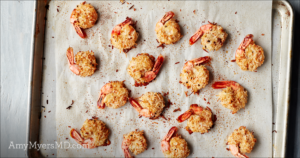
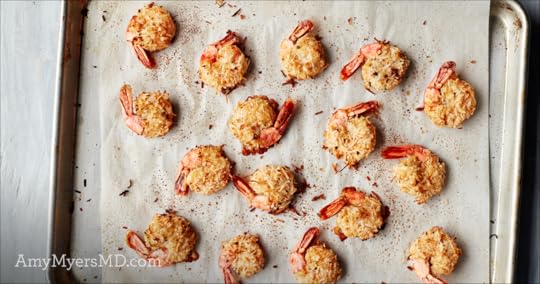
When I was growing up in New Orleans, my grandparents took the family out to dinner at the Yacht Club for special occasions, and I always ordered a fried shrimp po’boy—a traditional Louisiana sandwich. This substitute for fried shrimp is an AIP-friendly version that everyone will love!
My New Orleans-Style Crispy Coconut Shrimp are tossed with coconut flour and shredded coconut instead of breadcrumbs—and they are so easy to make! Double or triple the recipe for a party appetizer. My husband and I served this as an appetizer at our wedding, and it was a big hit!
Coconut Shrimp
CourseMain Dish, Side Dish
ProtocolAutoimmune Solution (AIP), Elimination Diet, Paleo, Thyroid Connection
Servings4 people
Ingredients
2 tbsp
coconut flour
1⁄2cup
unsweetened shredded coconut
1 tsp
garlic powder
1tsp
onion powder
1/2tsp
fine sea salt
1/2tsp
freshly ground black pepper
3/4cup
full fat coconut milk
1 1/2tbsp
coconut aminos
1pound
wild-caught shrimp
Instructions
Heat oven to 400°F. In a shallow bowl, whisk together coconut flour, shredded coconut, garlic and onion powders, salt, and pepper.
In another shallow bowl, whisk together the coconut milk and coconut aminos.
Dip each shrimp into the liquid mixture, and then into the dry mixture to coat. Arrange in a single layer in a baking dish. Bake for 15 to 20 minutes, until golden brown. For extra crispiness, remove the pan and set the oven to broil. Broil the shrimp for 4 to 5 minutes.
The post New Orleans-Style Crispy Coconut Shrimp appeared first on Amy Myers MD.
April 23, 2018
8 Foods to Repair Your Gut that You Should Be Eating
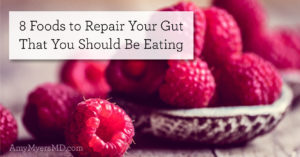
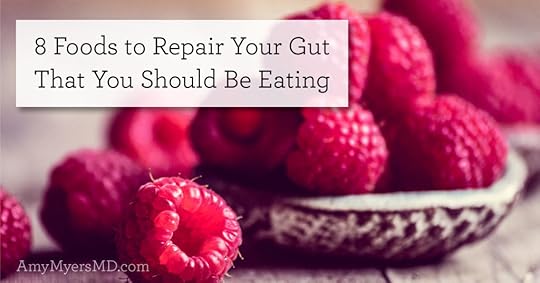
Your gut health plays a hugely important role in your overall health. It’s why I have all of my patients begin by repairing their gut, particularly anyone with autoimmunity. Fortunately, your gut cells turn over every 48 hours, so by following the 4R approach you can restore your gut health pretty quickly and start seeing your symptoms fade away.
In addition to removing toxic and inflammatory foods, there are certain foods with gut-repairing properties that can be really beneficial in helping to restore your gut lining. My upcoming cookbook, The Autoimmune Solution Cookbook (coming out May 8th), features recipes that include a number of these gut-friendly foods, and if you pre-order your copy today, you can get over $300 in FREE bonus resources!
Let’s take a look at some of the best foods that you should be eating to help repair your gut.
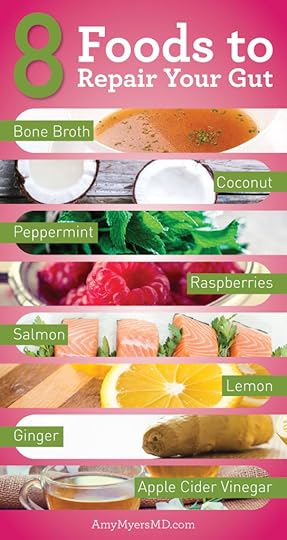
1. Bone Broth
It shouldn’t come as a surprise that bone broth is at the top of my list as one of the most important foods to repair your gut. Bone broth contains gelatin and collagen, two superstars for supporting a healthy mucosal lining, proper digestion, and intestinal functioning. Glucosamine in bone broth assists in repairing a leaky gut by combating inflammation and stimulating the growth of new collagen.1
Bone broth is super simple to make at home, and there are so many companies nowadays producing ready-made bone broth as well for when you don’t have the time to whip up your own batch!
2. Coconut
Coconut products of all kinds, including oil, cream, and yogurt, are antimicrobial, antifungal, and antiviral, which makes them extremely helpful when dealing with SIBO, yeast overgrowth (such as Candida), and parasites. Medium-chain triglycerides (MCTs) in coconut aid in nutrient absorption and have been shown to be particularly beneficial for managing gastrointestinal disorders.2 Coconut yogurt comes with the added bonus of probiotics to encourage the growth of good bacteria in your gut.
For a sneak peek of my Coconut Shrimp and other gut-repairing recipes from my cookbook, sign up for my newsletter!
3. Peppermint
Mint has been used medicinally for thousands of years, since the time of the ancient Greeks and Romans.3 Peppermint, a hybrid of water mint and spearmint, has antispasmodic properties that make it ideal for relieving irritable bowel syndrome (IBS) and other GI discomfort. The cooling menthol in peppermint relaxes the intestinal tract, reducing the pain, gas, and constipation associated with IBS just as effectively as prescription antispasmodics.4,5
I like to use mint in smoothies and tea for a bright, refreshing, and nutritional burst of flavor!
4. Raspberries
Fiber is essential for digestive health. Getting enough fiber in your diet helps prevent gut-related maladies, including constipation and diverticulosis.6 Recent studies have also shown the power of dietary fiber to reduce systemic inflammation and support a healthy immune response.7 However, most Americans fall short of the recommended daily amount of fiber intake, which is 25g for woman and 38g for men.8
That’s why raspberries earn a place on my list of the most important foods to repair your gut! A single cup of raspberries contains 8g of fiber–roughly a quarter of your daily fiber needs! Research has found that eating raspberries with a meal improves insulin sensitivity and satiety, and increases the amount of a certain type of good bacteria in your gut that is often depleted by conditions such as IBD.9,10,11
Raspberries make a great addition to smoothies and desserts. You can also try homemade gummy fruit snacks made with raspberry puree and gelatin!
5. Salmon
Wild, fatty fish such as salmon are an excellent source of Omega 3s and Vitamin D. Omega 3s reduce inflammation and increase healthy gut bacteria. Research has shown that Omega 3s could play an important role in reversing chronic gut-related illnesses, including metabolic disorder, obesity, and colorectal cancer.12 Meanwhile, low levels of Vitamin D have been associated with IBD and colon cancer. Increasing Vitamin D intake dramatically lowers inflammation and promotes the activity of friendly bacteria in your gut, helping to defend against infections such as Salmonella.13
My cookbook has a number of tasty salmon recipes, including inflammation-fighting Honey-Ginger Glazed Salmon and Roasted Sweet Potato Rounds with Smoked Salmon–my AIP spin on lox and bagels!
6. Lemon
Lemon is high in Vitamin C, an antioxidant that suppresses inflammation, boosts the immune system (nearly 80% of which is housed in your gut), and is antimicrobial to support a healthy bacterial balance in your microbiome. Vitamin C also plays a role in the formation of collagen–which, as we know, is necessary for optimal gut barrier function.14
Lemons are naturally detoxifying and help stimulate bile production to aid in digestion.15 Low bile acid is a risk factor for developing gastrointestinal issues such as SIBO.16 Lemons also contain pectin, a type of prebiotic fiber that feeds your good bacteria and decreases the number of bad bacteria in your gut.17 To get the most benefits from lemon, rather than just squeezing out the juice, try blending whole, peeled lemons and stir the puree into your water or throw lemon wedges right into your smoothie!
Also, be sure to check out my recipe for deliciously sweet-tart Lemon Bars!
7. Ginger
The humble ginger root is an age-old remedy for digestive complaints. Ginger is known for its ability to ease nausea, and can help relieve symptoms associated with IBS, including stomach cramps, gas, bloating, constipation, and diarrhea. It can also prevent heartburn by keeping acid from regurgitating back into the esophagus and killing harmful bacteria linked to acid reflux. What’s more, ginger can help with nutrient absorption, which is often compromised when you are dealing with a gut infection.18
One of my absolute favorite ways to use ginger is in my YUMMY Gingerbread Cake, featured in The Autoimmune Solution Cookbook! Ginger is also a key ingredient in my gut-friendly Golden Milk recipe.
8. Apple Cider Vinegar
Apple cider vinegar (or “ACV”) is a natural antimicrobial, and can inhibit the growth of a certain type of bacteria that is high in lipopolysaccharides (LPS), endotoxins that increase intestinal permeability and cause leaky gut.19,20 ACV also helps your body create hydrochloric acid (HCL). Contrary to what you might think, people dealing with GI issues such as gastroesophageal reflux disease (GERD) or acid reflux are actually low in stomach acid.21 Use ACV to naturally increase your body’s level of HCL to aid in digestion and nutrient absorption, as well as support a healthy immune response.22
I use apple cider vinegar in so many different recipes, from cassava tortillas to tangy coleslaw! It makes a great addition to salad dressings and homemade condiments as well.
Repairing your gut is the first essential step of The Myers Way®. Now that you know the perfect gut-repairing foods to add to your diet, you can start on your journey to optimal health and begin living the symptom-free life you deserve!
The post 8 Foods to Repair Your Gut that You Should Be Eating appeared first on Amy Myers MD.
April 20, 2018
Amazing AIP Lemon Bars

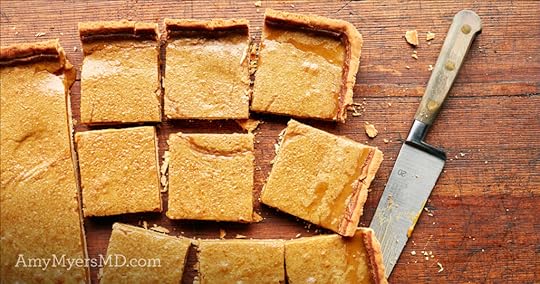
These lemon bars have just enough sweetness to balance the tart lemony flavor!
Amazing AIP Lemon Bars
CourseBreakfast, Dessert, Snack
ProtocolAutoimmune Solution (AIP), Elimination Diet, Paleo, Thyroid Connection
Ingredients
Crust
1 cup
coconut flour
1⁄4 cup
arrowroot flour
1 1⁄3 cup
palm shortening
1⁄4 cup
maple syrup
Filling
1 1⁄3 cups
freshly squeezed lemon juice
1 cup
coconut sugar
pinch
ground turmeric
1 1⁄2 cups
coconut cream
1/4cup
arrowroot flour
Instructions
Heat oven to 350°F. Grease an 8-by-8-inch baking dish with coconut oil.
In the bowl of an electric mixer, mix together the coconut flour and arrowroot flour. Add the palm shortening and maple syrup and beat on low until the dough comes together. Using your fingers, gently press the dough into the bottom of the prepared dish.
Bake for 10 minutes. Remove the pan from the oven and lower the temperature to 325°F.
In the bowl of an electric mixer, beat together lemon juice, coconut sugar, turmeric, coconut cream, and arrowroot flour on medium speed until combined. Pour on top of the crust. Bake for 20 minutes or until filling starts to set (filling will set more when it’s refrigerated). Remove from oven and
let the bars cool for 10 minutes. Refrigerate for 30 minutes and allow to set completely before serving. Slice into bars.
The post Amazing AIP Lemon Bars appeared first on Amy Myers MD.
April 18, 2018
10 Signs You Have Small Intestinal Bacterial Overgrowth (SIBO)


Have you ever eaten something and within a few hours realized that your stomach is so bloated that you can’t button your pants? It’s not uncommon for my patients to tell me that they wake up with a flat belly and by the end of the day they look six months pregnant.
Even if you haven’t experienced abdominal swelling to such an extreme, any amount of bloating is not normal; it’s a sign of intestinal inflammation. If you’re having gas or bloating regularly, or are dealing with IBS, there’s a strong likelihood you could have Small Intestinal Bacterial Overgrowth (SIBO).
What is SIBO?
As you might guess, Small Intestinal Bacterial Overgrowth, or SIBO, occurs when the bacteria in your small intestine get out of balance and overgrow.
The bacteria in your GI tract, which make up your gut microbiome, play a vital role in your immune system, thyroid function, bone health, and overall health. In fact, scientists have discovered that the gut microbiome contains tens of trillions of microorganisms, including up to 1,000 different species of bacteria with over 3 million genes — that’s 150 times more genes than human genes!
However, most of your gut bacteria is meant to be located in your large intestine and colon, where they help to break down food, synthesize vitamins, and eliminate waste. When these “healthy” bacteria that are normally found in the large intestine and colon colonize the small intestine, SIBO occurs.1 SIBO can also be caused by an overgrowth of otherwise normal bacteria in the small intestine itself. As I always say, “Too much of a good thing can be a bad thing,” and this is true of SIBO.
The excess bacteria then feed off of the undigested food in your small intestine. In particular, they love to feed on sugar, simple and complex carbohydrates, starches, and alcohol – they’re real carb fiends!
As the bacteria feeds, it causes the carbohydrates to ferment, which produces hydrogen as a byproduct. Hydrogen can in turn feed single-celled organisms in your small intestine called archaea, which then produce methane as a byproduct. So when you have SIBO you have excess levels or hydrogen, methane, or both in your digestive system.
Carbohydrates feed SIBO → SIBO produces hydrogen → hydrogen feeds archaea → archaea produces methane
Depending on which gas is most predominantly produced, you can develop different symptoms and respond better to different treatments. Hydrogen-dominant SIBO typically leads to diarrhea, whereas methane-dominant SIBO is usually associated with constipation. I go into more detail on the two types of SIBO later.
The effect of all of this excess gas in your GI tract is what you might imagine. It leads to belching, flatulence, and can cause severe bloating. In fact, many people with SIBO report feeling like they’re 6 months pregnant by the end of the day!
Fortunately, once you get the bacteria under control and restore your gut’s natural balance, you can eliminate these frustrating digestive symptoms.
However, it’s not just digestive issues. SIBO can lead to a wide-ranging array of symptoms, including:
10 Signs You Have SIBO
1. Gas, bloating, and diarrhea
2. Abdominal pain or cramping
3. Constipation (much less common than diarrhea)
4. Diagnosis of irritable bowel syndrome (IBS) or inflammatory bowel disease (IBD)
5. Food intolerances such as gluten, casein, lactose, fructose, and particularly histamine intolerance
6. Chronic illnesses such as fibromyalgia, chronic fatigue syndrome, diabetes, neuromuscular disorders and autoimmune diseases
7. Vitamin and mineral deficiencies, including vitamins A, B12, D, and E
8. Fat malabsorption (signified by pale, bulky, and malodorous stools)
9. Rosacea and other skin rashes
10. Leaky gut
Because of the many ways its symptoms manifest in different people–sometimes showing no physical signs whatsoever–SIBO often goes undiagnosed. In fact, an estimated 6-15% of healthy, asymptomatic people and roughly 80% of people with IBS are actually suffering from SIBO.2
What causes the bacterial overgrowth?
Our gut relies on nerves, muscles, enzymes, and neurotransmitters to properly digest food. While enzymes mainly break down our food, the nerves, muscles and neurotransmitters physically move the food through our digestive tract from the stomach to the small intestine and to the colon. When this happens in a healthy gut, bacteria gets passed through the digestive tract along with the food to its final destination in the colon. Problems arise when something interferes with this process.
Damage to the nerves or muscles in the gut can result in leftover bacteria in the small intestine, increasing your risk for SIBO. For example, diabetes mellitus and scleroderma can both affect the muscles in the gut, leaving room for SIBO to develop.
Physical obstructions in the gut, like scarring from surgeries or Crohn’s disease, can also cause an abnormal buildup of bacteria in the small intestine. Diverticuli, which are tiny pouches that can form in the wall of the small intestine, can also collect bacteria instead of passing it on to the colon, where it belongs.
There are also medications that influence or disrupt the normal gut flora, such as antibiotics, acid-blocking drugs, and steroids. And of course, as I mentioned above, the most common cause for SIBO I see in my patients is from a diet high in sugar, refined carbohydrates and alcohol.
How to Test for SIBO
Before I explain which types of lab tests for SIBO are most effective and accurate, let’s recap the two different types of SIBO so that you can understand their role in testing.
Hydrogen vs Methane SIBO
As I explained earlier, when you have an overgrowth of bacteria in your small intestine, the carbs you eat are able to ferment before they can be broken down. This fermentation process releases hydrogen as a byproduct, so people with SIBO have elevated levels of hydrogen in their GI tract. This is why one of the most effective methods for diagnosing SIBO is to test the levels of hydrogen in your gut using a breath test.
However, you’ll remember that SIBO can also cause an increase in methane levels because the hydrogen feeds single-cell organisms in your gut called archaea, which produce methane. This can actually help reduce your hydrogen levels, and explains why you can have a false negative hydrogen test result and yet still have SIBO.
Studies have shown that high methane production is associated with constipation, and that patients who were treated for a bacterial overgrowth saw an improvement in their bowel regularity.3 So if you have SIBO and are dealing with constipation (which is less common), you likely have methane-producing SIBO.
Methanogens also lead to increased production and absorption of short-chain fatty acids, and have been linked to higher rates of obesity. In fact, one study found that people with higher intestinal methane production had higher BMIs.4
The reason this is so important is that you ideally want your lab testing to identify which type of SIBO you have, because they respond differently to different treatment options.
Lab Testing Options
1. Breath Test
This is by far the gold standard when it comes to SIBO lab testing because it is the most accurate and also determines if your SIBO is hydrogen or methane dominant. However, it can be a bit cumbersome.
You’ll need to fast for 12 hours, and breathe into a small balloon to measure your baseline levels of hydrogen and methane. Then you’ll ingest a precise amount of sugar (which feeds the bacteria) and repeat breath samples every 15 minutes for 3 or more hours to see if your levels of hydrogen or methane increase.
If your hydrogen levels are high then you likely have hydrogen-dominant SIBO, and vise versa. However, just because one gas is dominant doesn’t mean that only one type of gas is present. You can have both types of gas present, one is just more prevalent.
I recommend the Lactulose Breath Test from Aerodiagnostics.
2. Organix Dysbiosis Test
This functional medicine lab tests the urine for by-products of yeast or bacteria in the small intestine. If your small intestine is housing a yeast or bacterial overgrowth, byproducts will appear in your urine, indicating their presence. This test is much easier for patients and only requires one single urine specimen. However, it doesn’t determine whether your SIBO is hydrogen or methane-dominant.
3. Comprehensive Stool Test
This is also a functional medicine lab test looking at the flora of the large intestines. If I see all elevated levels of good bacteria, I suspect SIBO. Because my patients are typically dealing with multiple, overlapping gut issues such as Candida overgrowth, SIBO, and parasites, I often use stool testing so that we can test for multiple gut infections at one time.
4. Symptoms Checklist
Using the list of symptoms above and looking at a patient’s health history to see if the lifestyle factors associated with SIBO are present, I am often able to make a diagnosis simply by listening to the patient.
3-Step Protocol for Treating SIBO
Treating SIBO is a 3-step approach that works to eliminate the overgrowth and restore your gut’s natural balance on 3 fronts.
Step 1: Starve the Overgrown Bacteria
The first step is to remove the foods that feed the bacteria in your small intestine, including sugar, alcohol, and carbohydrates. This includes the usual suspects, such as bread, cookies, cake, and cocktails, as well as complex carbohydrates such as whole grains and legumes. Ultimately these foods are broken down into sugar in your gut, which feed the bacteria.
During this time you’ll eat plenty of non-starchy vegetables, leafy greens, lean proteins, and healthy fats, with minimal fruit.
Step 2: Attack the Bacteria
In my clinic I typically use the antibiotics Xifaxan and Neomyacin to attack the bad bacteria, depending on which gas is more dominant. Xifaxan is more effective with hydrogen-dominant SIBO and Neomyacin tends to be more successful with methane-dominant SIBO. These antibiotics work exceptionally well to kill the pathogenic bacteria with the least amount of disruption to the good bacteria in your microbiome.
If you are treating your SIBO at home, as thousands have done successfully, the protocol is to use Microb Clear , which is a blend of magnesium caprylate, berberine, and extracts from tribulus, sweet wormwood, grapefruit, barberry, bearberry, and black walnut. These ingredients work to kill off the bacteria naturally.
, which is a blend of magnesium caprylate, berberine, and extracts from tribulus, sweet wormwood, grapefruit, barberry, bearberry, and black walnut. These ingredients work to kill off the bacteria naturally.
While they aren’t specific to pathogenic bacteria and can disrupt your good bacteria, they aren’t as harsh as broad spectrum prescription antibiotics, which are like a bomb that wipes out good bacteria and bad bacteria alike. Microb Clear is much more natural and gentle. You can think of its effect more like pruning, rather than a bomb.
is much more natural and gentle. You can think of its effect more like pruning, rather than a bomb.
Step 3: Restore Your Good Bacteria
The final step is to restore the good bacteria in your gut to support a strong immune system and optimal digestion and nutrient absorption. However, when it comes to SIBO you want to be particularly careful because certain probiotics can actually add more fuel to the fire.
The Problem with Most Probiotics
When you have an overgrowth of bad bacteria in your small intestine, the bacteria are often of the lactobacillus or bifidobacterium species. And since the majority of probiotic supplements out there contain lactobacillus or bifidobacterium, using this type of probiotic is adding to the bacteria in your small intestine and throwing fuel on the fire.
In fact, one clue that you may have SIBO is that when you take a probiotic containing lactobacillus or bifidobacterium you have an exacerbation of your symptoms such as more gas, bloating, constipation, diarrhea or other digestive symptoms.
Why Soil-Based Probiotics Are Best for SIBO
Soil-based probiotics, such as my Primal Earth Probiotic, will not exacerbate your symptoms or add fuel to the fire because they don’t colonize the small intestine or feed the bacteria already growing there, since they don’t contain lactobacillus or bifidobacterium strains, yet they still provide all the benefits of a probiotic.
Probiotic, will not exacerbate your symptoms or add fuel to the fire because they don’t colonize the small intestine or feed the bacteria already growing there, since they don’t contain lactobacillus or bifidobacterium strains, yet they still provide all the benefits of a probiotic.
Soil-based probiotics also have a seed-like structure that protects them from stomach acid, bile salts, and digestive enzymes so that the bacterial strains remain alive. They can actually sense when the environment is safe for them to emerge and begin colonizing your large intestine and colon. This makes them a great option for SIBO because they don’t populate the small intestine and contribute to bacterial overgrowth there, instead heading straight to the large intestine and colon where they can support vibrant health.
The post 10 Signs You Have Small Intestinal Bacterial Overgrowth (SIBO) appeared first on Amy Myers MD.
April 17, 2018
3 Important Reasons to Give Up Gluten if You Have an Autoimmune Disease

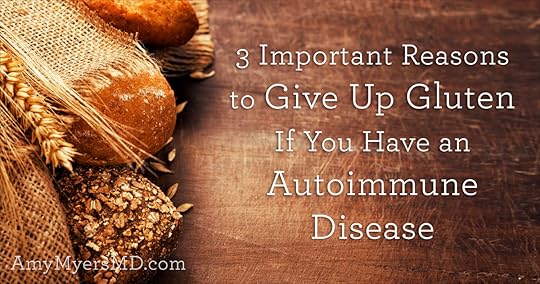
Do you have Lupus, Rheumatoid Arthritis, Hashimoto’s, Multiple Sclerosis, or any other autoimmune disease? If so, I can say without a doubt that gluten sparked the flame of your disease, and continuing to eat it is simply adding fuel to the fire.
Gluten, a protein naturally found in certain grains, is now found nearly everywhere in our modern world. It’s of course in flour-based foods such as pasta and bread, but it is also used as a filler in medications and supplements, it’s the glue that holds meat substitutes together, it’s in body products such as shampoo and toothpaste, and, thanks to cross-contamination, it’s even in grains that are marked gluten-free.
I want to point out that our modern-day gluten is not the same gluten that your grandparents ate. In order to create ever fluffier pastries and hardier wheat, scientists developed new hybrid strains of wheat that contain entirely new forms of gluten not found in any of the original plants, and this is what makes our muffins and bagels bigger and fluffier. Scientists were also able to deaminate gluten which allows it to be dissolved into liquids and other products that didn’t previously contain gluten, like lunch meat and shampoo. These two factors mean that we are not only eating a different kind of gluten than our ancestors ate, we are eating and being exposed to way more of it.
This modified and now ubiquitous protein causes problems with both your gut health and your immune system, creating a perfect storm for the development and progression of inflammatory and autoimmune disease. Even if you do not have an inflammatory or autoimmune disease, eating gluten can still be harmful to your health, as it has been linked with more than 55 diseases. The bottom line is that if you have an autoimmune disease, or any inflammatory condition, you shouldn’t be eating gluten, period. Here are three reasons why.
1. Gluten Causes Leaky Gut
When you eat gluten, whether via a piece of bread, the filler in your lunch meats, or one of many hidden sources, it travels through your stomach and arrives in your small intestine, where we know from Dr. Alessio Fasano’s research that it triggers the release of zonulin. Zonulin is a chemical that signals the tight junctions of your intestinal wall to open up, creating intestinal permeability, also known as leaky gut.
You can think of your gut lining kind of like a drawbridge. Teeny tiny boats (micronutrients in food) that are meant to travel back and forth are able to go under the bridge without a problem. But, when gluten releases zonulin, it causes the drawbridge to go up, allowing bigger boats (large proteins like gluten) to cross over that aren’t meant to travel through. In the case of your gut, it’s microbes, toxins, proteins, and partially digested food particles that are passing under the drawbridge and escaping into your bloodstream.
This condition of leaky gut has been shown via Dr. Fasano’s research (and I’ve confirmed it in my own practice) to be one of the preconditions for developing an autoimmune disease. And, once you have an autoimmune disease, leaving your leaky gut untreated can cause your condition to progress and places you at higher risk of developing another autoimmune disease. So what is the link between a leaky gut and autoimmune disease?
Since all of the toxins, microbes, and food particles such as gluten now flooding your bloodstream aren’t supposed to be there, your immune system marks them as dangerous invaders and creates inflammation to get rid of them, which leads us to point number two.
2. Gluten Causes Inflammation
If you have an autoimmune disease, then that means that somewhere along the way, your immune system went rogue and began attacking your body’s own tissues. This change from healthy to autoimmune isn’t instantaneous, it happens over years. As I explain in my book, it’s a spectrum, and the factor that pushes you up the spectrum and towards autoimmunity is inflammation.
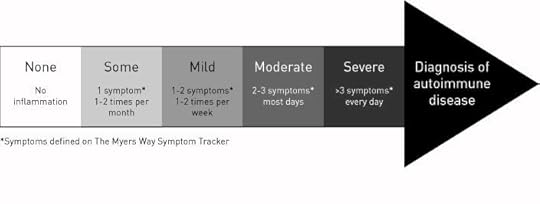
Inflammation is your immune system’s natural response to anything it deems dangerous, whether that’s a cut, a virus, or the gluten that you ate in a piece of birthday cake that slipped through your leaky gut. It’s estimated that one percent of the population has Celiac disease and one in 30 people have a gluten sensitivity–and eating gluten causes inflammation every time they eat it. What’s more, an estimated 99 percent of people with gluten sensitivity are undiagnosed, so they are fanning the flames of their inflammation without even knowing it.
When your immune system is continuously creating inflammation in response to the gluten you’re eating, your leaky gut, and the microbes and toxins flooding your bloodstream, you develop chronic inflammation. Your immune system is now stressed and is less able to attack pathogens and invaders with precision. Instead, it begins indiscriminately sending wave after wave of attack in a desperate attempt to fight off the invaders. Eventually, your body’s own tissues end up on the receiving end of the attack, and you end up with an autoimmune disease.
The only way to give your immune system the break it needs to regain its precision so that it can stop mistakenly attacking you, is to remove gluten entirely. That last word, entirely, is important because recent research has shown that eating gluten can elevate your gluten antibodies for up to three months, meaning that even if you only ate gluten four times a year, you would be in a state of inflammation year-round.
3. Gluten Looks Like Your own Tissues
Beyond creating a leaky gut, gluten poses a serious risk for those of us with autoimmunity because of a phenomenon called molecular mimicry, which is a dangerous case of mistaken identity.
Every time your body is exposed to an invader (in this case gluten), your immune system memorizes its structure so that it can develop the perfect defense to that pathogen and recognize it in the future. Unfortunately, the immune system’s recognition system isn’t perfect; as long as a molecule’s structure is similar enough, the immune system registers it as an invader and attacks. Gluten, which is a particularly large protein, happens to be structurally similar to a number of your body’s tissues, particularly your thyroid. Remember, if you have an autoimmune disease, you have a leaky gut and when your ‘drawbridge is open’ large proteins like gluten get into your bloodstream where your immune system detects and attacks them.
In those with autoimmune thyroid disease, every time they eat gluten the immune system sends out antibodies to detect and destroy the gluten, but since the gluten and thyroid gland looks so similar some of those immune cells end up attacking the thyroid by mistake.
There are several other food proteins, such as casein in dairy, that have a similar molecular structure to gluten. Because of this molecular mimicry, when you eat dairy your body can get confused and think you just ate a bowl of pasta and trigger an immune reaction.
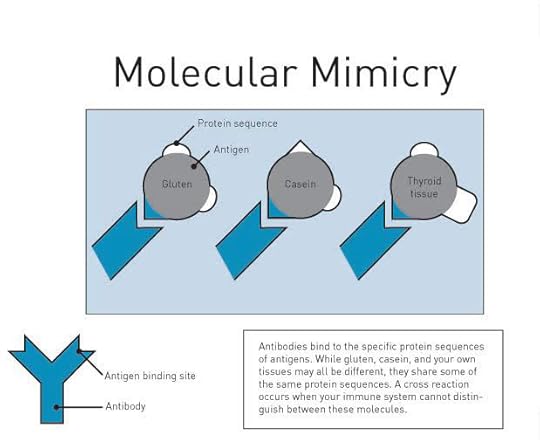
How to Heal the Damage Caused by Gluten
If you have an autoimmune disease or are anywhere on the autoimmune spectrum, the single best thing you can do for your health is to ditch the gluten 100% as soon as possible. If you don’t, the gluten will keep your tight junctions open and your gut leaky, your body may mistake your own tissues for gluten by way of molecular memory, and your body will remain in a chronic state of inflammation. In addition to eliminating gluten, I recommend using the proven 4R approach to heal your leaky gut. These two steps combined will give your immune system the break it needs to stop your body’s attack on itself.
In fact, healing your gut and removing gluten from your diet are two of the most impactful changes you can make in reversing your autoimmune disease, and they are the first two pillars of The Myers Way®. I walk you through all four pillars for preventing & reversing autoimmunity, as well as provide over 150 amazingly delicious and simple gluten-free recipes in my new cookbook, The Autoimmune Solution Cookbook, coming out May 8th! Be the first to get your copy by pre-ordering now, and you’ll also receive over $300 in bonus resources to make AIP cooking even easier!
The post 3 Important Reasons to Give Up Gluten if You Have an Autoimmune Disease appeared first on Amy Myers MD.
April 16, 2018
What to Eat (and Not Eat) to Reverse Autoimmune Disease

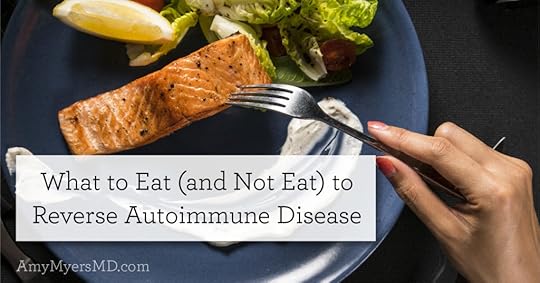
Conventional doctors told me–and they’ve probably told you too–that autoimmunity is a condition that you just have to live with, either by managing the symptoms with harsh medications, taking other extreme measures such as surgery or, as in the case of my Graves’ disease, having your thyroid blown up with radioactive iodine. I want you to know that there IS another way. Conventional medicine failed me, and I have made it my mission to not let it fail you too. What your doctor won’t tell you is that autoimmune disease can be prevented and reversed through diet and lifestyle.
Food, in particular, plays an enormous part in achieving optimal health by providing the essential nutrients your body and immune system need to thrive. However, it’s a double-edged sword because food is also one of our biggest sources of inflammation (the root of all chronic illness) since our modern diets are loaded with toxic and inflammatory foods. Certain foods, particularly gluten and dairy, lead to leaky gut, which is a necessary precursor to autoimmunity and leads to even more inflammation.
Fortunately, by removing toxic and inflammatory foods from your diet and adding in nourishing foods that support your health, you can reduce your inflammation and work your way back down the autoimmune spectrum.
I know because I’ve done it myself. In fact, I’ve spent years researching and experimenting with how to optimize your diet for autoimmunity, and the process led me to make some pretty dramatic changes along the way. After over 20 years as a vegetarian, I added in organic, grass-fed, and pasture-raised meat, and said goodbye to the grains and legumes that had been staples of my diet for years.
It was certainly an adjustment at first. Yet after seeing the changes in my lab results and watching my symptoms fade away, I knew this was what my body needed and am fully committed to eating this way for life. Since then, I’ve also worked with thousands of patients who are now living symptom-free, vibrant lives after optimizing their diets as well.
I’ve seen the power of food firsthand, and I want you to experience it too!
Click To Tweet
So, if you’re just getting started or need a refresher, I’ve summarized the most important steps you can take to ditch the foods that are perpetuating your symptoms and add in the nutrient-dense foods that will support your immune system and put you on the path to lifelong, optimal health.
If you’re ready to put this proven approach to reversing autoimmunity into practice with over 150 amazingly delicious recipes specifically designed to restore your health, be sure to check out The Autoimmune Solution Cookbook (and get over $300 in FREE bonus resources!).
Toss All Toxic and Inflammatory Foods
The first step in optimizing your diet is to clear your cabinets and fridge of all toxic and inflammatory foods. These are foods that contribute to inflammation and leaky gut, sending you straight up the autoimmune spectrum. When you realize how much better you feel after getting these bad-for-you foods out of your diet, I promise you’ll never want to go back to that way of eating again!
Toxic Foods
The following “foods” have no place in a healthy lifestyle, and should be avoided completely:
Sugar
Alcohol
Caffeine
GMOs
Artificial sweeteners
Additives, preservatives, and dyes
High-fructose corn syrup
Processed food, junk food, and fast food
Trans or hydrogenated fats
Inflammatory Foods
In addition to the above toxic foods that I recommend everyone toss for good, there are certain foods that can be highly inflammatory and lead to leaky gut that you’ll want to cut out for the first 30 days on The Myers Way® to allow your gut to repair itself. You can then reintroduce (most of) these foods one at a time to determine if you personally tolerate them or if you have a sensitivity. See my article on food sensitivities for step-by-step instructions on how to follow an elimination diet. My books, The Autoimmune Solution, The Thyroid Connection, and The Autoimmune Solution Cookbook, all walk you through this process as well.
The most common inflammatory foods implicated in food intolerances are listed below:
Gluten
Dairy
Gluten-free grains
Legumes
Corn
Soy
Eggs
Nightshades (tomatoes, peppers, potatoes, and eggplant)
Citrus
Yeast
Gluten and Dairy
Gluten and dairy are at the top of my list of foods you should never eat, especially if you have an autoimmune disease. In addition to being highly inflammatory, gluten triggers the release of zonulin in your small intestine, which causes the tight junctures in your gut to open up, creating a leaky gut. According to the research of Dr. Alessio Fasano, leaky gut is a necessary precursor to autoimmunity, so you’ll want to ditch gluten permanently to ensure your gut is repaired.
Gluten can also lead to molecular mimicry, a phenomenon when a foreign antigen (such as gluten) is so structurally similar to your body’s own tissues that when your immune system creates antibodies to attack the invader, it mistakenly attacks your own tissues in the process.1 Gluten is structurally similar to a number of your body’s tissues, particularly the thyroid gland, which is why gluten is one of the leading causes of autoimmunity, especially autoimmune thyroid conditions.
The casein protein in dairy is also structurally similar to gluten and your thyroid tissue, making it another major culprit in molecular mimicry. Plus, it is highly inflammatory for a number of reasons. Around 70% of the world’s population stops producing lactase once they’ve finished breastfeeding.2 and cannot properly digest dairy. In addition many people experience dairy sensitivities because they do not tolerate casein or whey (two proteins found in milk). Plus, conventional dairy tends to be full of hormones and antibiotics, both of which can lead to or exacerbate autoimmune disease.
Grains and Legumes
I also recommend that all of my autoimmune patients eliminate grains and legumes, for at least thirty days and possibly for good. This is because grains and legumes contain two problematic groups of substances: lectins and agglutinins.
Prolamin, a type of lectin found in quinoa, corn, and oats, behaves similarly to gluten. So if you have Celiac disease or any other type of autoimmune condition, prolamins can damage your gut and trigger an immune reaction. Grains and legumes also contain agglutinins, which have been shown to cause leaky gut and disrupt your immune system by stimulating the immune system and binding with immune cells.
When you’re on the autoimmune spectrum, you don’t want to stress your immune system out even more by introducing these hazardous compounds, particularly while you’re working on repairing your gut. If you find you do tolerate some gluten-free grains and legumes, you can slowly begin to reintroduce them in small quantities after the first 30 days and once your gut has repaired.
Corn and Soy
Corn and soy are problematic because 88% of corn and 93% of soy crops are genetically modified.3 GMOs have been linked to at least 22 diseases, including diabetes, Alzheimer’s, and multiple sclerosis.4 Not to mention, the proteins in corn can cross-react with gluten, and soy contains isoflavones that can cause estrogen dominance.
Eggs
Eggs should be eliminated due to the ability of lysozyme (found in egg whites) to penetrate the gut barrier and enter your bloodstream, triggering leaky gut.5
Nightshades
Nightshade vegetables such as potatoes, eggplant, tomatoes, and peppers contain alkaloids that contribute to inflammation and are not well tolerated by those with autoimmunity.6
Citrus
Citrus fruits are rich in histamine, which triggers your body’s natural immune response. For this reason, high-histamine foods should be avoided to prevent further inflammation and exacerbation of an existing autoimmune condition.
Yeast
Foods containing yeast can cause an imbalance of your gut flora that leads to Candida overgrowth and SIBO. Both of these conditions contribute to leaky gut and set you on the path to autoimmune disease and chronic illness.
Go Organic Whenever Possible
It’s particularly crucial for people with autoimmunity to choose organic foods whenever possible because conventionally grown produce is full of toxins (including pesticides, herbicides, and fungicides) that mess with your system, contribute to inflammation, and cause symptom flare-ups.
In fact, Pesticides have been directly linked to autoimmune disease. One study that looked at 300,000 death certificates over fourteen years showed that farmers who were exposed to pesticides while working with crops were more likely to die from a systemic autoimmune disease.7 And if you already have an autoimmune disease, you are three times more likely to develop a second one, which is why limiting pesticide exposure is so critical. Washing or peeling non-organic fruits and vegetables doesn’t help either, because most of the chemicals used in agriculture are systemic, meaning they are integrated into the flesh of the crop.
Organic produce is also more nutritious than conventional. A recent study showed that organic produce is richer in nutrients and antioxidants and lower in pesticides and heavy metals, which are a contributing factor to autoimmunity.8 Taming the toxins is the third pillar of The Myers Way®, and so minimizing your exposure to chemical fertilizers, pesticides, herbicides, fungicides, and heavy metals is essential to reversing your condition.
The good news is, with the rising demand for organic produce, it’s much easier these days to find affordable, readily available organic food in most stores and online. If you aren’t able to buy all organic, you can prioritize which produce items to always buy organic and which you can get away with buying conventional by following the Environmental Working Group’s “Clean Fifteen” and “Dirty Dozen” lists.
Enjoy Nutrient-Rich Foods that Support Your Immune System
Now that you’ve gotten rid of the toxic and inflammatory foods that contribute to autoimmunity, you can focus on eating the nourishing, high-quality foods that will support your immune system and help reverse your symptoms. You will feel empowered knowing that the food you eat is going to make you feel so much better, and you will begin to see your migraines, fatigue, digestive issues, skin rashes, mood imbalances, and more disappear. You’ll feel energized, focused, and clear, your skin will glow, and in time many people find that they’re able to reduce or even eliminate their medications altogether! Most of all, you will discover that having an autoimmune disorder doesn’t need to stop you from living the life you want and that you deserve.
High-Quality Protein
Eating plenty of high-quality protein will provide you with the amino acids you need to support your immune system, among other benefits. It’s particularly important to prioritize organic, grass-fed, pasture-raised, and wild-caught meat, since animals are at the top of the food chain and the effects from GMO-feed and pesticides become magnified when we eat them. Not to mention, conventionally raised livestock typically have tons of added hormones and antibiotics, which put you at increased risk of numerous chronic illnesses.
My favorite sources of protein are organic, pasture-raised chicken and wild-caught salmon. I’ll also eat 100% grass-fed beef a few times a week. In addition to these, you can enjoy grass-fed lamb and pork, pasture-raised duck and turkey, wild-caught fish (such as cod or halibut), and wild game. We buy our grass-fed, pasture-raised meats from Butcher Box and our seafood from Vital Choice.
Vegetables
A good general rule of thumb is to aim for half of your plate to be vegetables at any meal. And you’ll particularly want to add in lots of leafy greens, including kale, spinach, arugula, and bok choy, because they are loaded with micronutrients, are naturally detoxifying, and are an excellent source of fiber to keep your gut functioning optimally.
Beyond that, there is an abundance of other vegetables you can add to your diet. Your goal should be to eat a rainbow of foods!
Some of my favorite veggie staples are broccoli, cauliflower, zucchini, asparagus, beets, sweet potatoes and squash. Try experimenting with different vegetables to see what appeals to your taste, and don’t be afraid to try something new!
Fruit
Fruits contain many essential nutrients including Vitamin C, potassium, and folate. Vitamin C in particular is necessary for the growth and repair of all your body’s tissues. Whole fruits are also an excellent source of fiber, which prevents constipation and supports the friendly bacteria in your gut that are so crucial to immune functioning.9
Berries are one of my favorite fruits because they’re low in sugar and packed with antioxidants. I throw a handful of raspberries, blackberries, blueberries, and strawberries into my smoothie almost every morning.
Healthy Fats
Despite what the (misguided) low-fat craze of the past few decades led us to believe, healthy fats are a key component of a balanced diet. They help repair the cells of your gut wall and assist in the absorption of fat-soluble vitamins such as A, D, K, and E. Not to mention, fats taste great and keep you feeling full and satisfied!
Avoid bad fats including trans fats and industrial seed oils (such as canola, soy, and corn), and instead focus on good fats (avocado, coconut and olive oils, and animal fats). Avocados are one of my favorite sources of healthy fat, and I often bring one with me when I’m traveling for an easy, filling snack!
Remember, you have the power to choose how you nourish your body and these choices can have an incredible impact on your health!
For over 150 recipe ideas that are autoimmune-friendly (and delicious!), be sure to check out my upcoming book, The Autoimmune Solution Cookbook, which releases May 8th! Plus, if you pre-order now, you can get over $300 in FREE bonus gifts!
The post What to Eat (and Not Eat) to Reverse Autoimmune Disease appeared first on Amy Myers MD.
April 15, 2018
8 Toxins Hiding in Your Cleaning Products
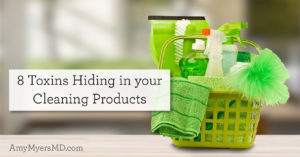
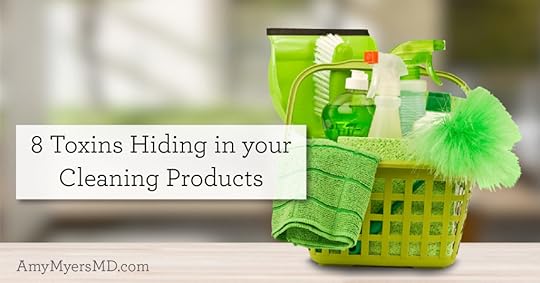
It’s that time of year when many people decide to tackle spring cleaning, reaching for the mops, brooms, and brightly labeled cleaning products. What you might not realize is that many of those bottles featuring cheery lemons or cute bubbles are actually loaded with toxins that can contribute to autoimmunity and other chronic health issues.
They can impact your health as you breathe them in while cleaning and even afterward as they linger in the air. In fact, because we spend nearly 90% of our time indoors, the Environmental Protection Agency (EPA) ranks indoor air pollution as one of the top 5 environmental risks to public health.
You can also absorb these toxic chemicals through your skin while you’re scrubbing away. Remember, your skin is your largest organ and it absorbs whatever you put on it, sending any toxic chemicals straight into your bloodstream, which can add to your toxic burden.
As I explain in my books, this chronic, low-level exposure to toxins can actually be more damaging to your health that one large exposure that happens all at once. It’s why taming the toxins is one of the five key steps in The Myers Way®, and why it’s so important to make smart choices about the products that you use regularly, since their combined impact can make a huge difference.
In this article I’m going to explain the problem with most cleaning products available, walk you through 8 of the most common toxins hiding in them, and how to replace them with safer alternatives, so that your home can be sparkling clean and toxin-free!
The Dirty Truth About Home Cleaning Products
According to the EWG (Environmental Working Group), U.S. law allows manufacturers of cleaning products to use almost any ingredient they wish, including known carcinogens and substances that can harm fetal and infant development. What’s more, the government doesn’t review the safety of products before they’re sold.1 As with the beauty industry, the government relies solely on the companies themselves to test and determine the safety of new chemical ingredients. Currently 80,000 chemicals are registered for use in the US, and each year about 1,700 are added to this list with little to no testing.
Furthermore, if you try to read the labels of most cleaning products, you will find their ingredients list incomplete. That’s because the companies that make cleaning products aren’t even required to list the ingredients on their packaging. The EWG found that out of 1,000 cleaning product labels they studied, 48% listed three or fewer ingredients on the label. These incomplete lists of ingredients are often accompanied by pretty serious warning labels, although even those don’t tell the full story.
It’s true that there are often warnings for poor reactions that can happen as a result of acute exposure such as skin burns or headaches from noxious fumes. However, as I mentioned, one of the biggest risks from these toxic chemicals is the destruction they cause through regular, low-level exposure. Constant exposure to toxins can stress your immune system, damage your tissues, and has been linked with autoimmune disease, asthma, cancer, reproductive disorders, hormone disruption, and neurotoxicity. It should come as no surprise then that as the use of manufactured household cleaners has increased, so has the incidence of these chronic health conditions.
8 Toxic Ingredients to Avoid
Although reading the (often incomplete) ingredient list on your cleaning products won’t 100% ensure you’re avoiding toxins, it can be really helpful for avoiding the worst and most common offenders.
Here’s a list of some key ingredients to avoid, products where they are commonly found, and suggestions for safer alternatives.
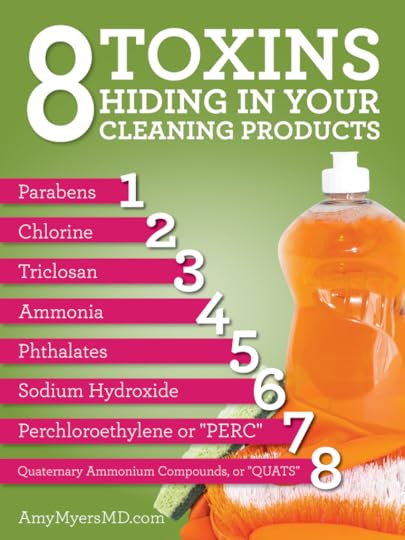
Parabens
Found in: This toxic chemical is one of the top offenders in both our household cleaners and beauty products. Any household products that claim to be antifungal or antimicrobial (including dish soap, all-purpose cleaner, glass cleaner, bathroom cleaner, and more) most likely contain parabens, listed as methylparaben, propylparaben, and butylparaben.
Health risks: Parabens are xenoestrogens, meaning they mimic estrogen in your body and can lead to estrogen dominance. As a result, they cause hormone disruption, reproductive problems, and have been linked with hormonal cancers including breast, ovarian, and uterine cancer. They can also cause neurotoxicity and skin irritation.
Healthier alternative: Avoid using all products with “antifungal” or “antimicrobial” claims, and always aim for organic, all-natural products by companies such as Mrs. Meyer’s or Dr. Bronner’s. Homemade cleaners are almost always the best choice, because you know exactly what’s in them. I’ve included a recipe below of a DIY, toxin-free all-purpose cleaner that can replace many of your paraben-containing products, and I’ve included several more home cleaning and beauty product recipes in The Autoimmune Solution Cookbook.
Triclosan
Found in: Triclosan and triclocarban are used as antimicrobial agents in cleaning products. Triclosan specifically is used in liquid dishwashing detergent and hand soaps labeled “antibacterial”, as well as toothpaste, mouthwash, deodorants, and cosmetics.
Health risks: Triclosan, which is classified as a pesticide, is an antibacterial agent that can contribute to the growth of drug-resistant bacteria. It can affect your body’s endocrine system, which produces hormones that regulate metabolism, growth and development, tissue function, sexual function, reproduction, sleep, and mood. It is also irritating to the skin and eyes.
Healthier alternative: Avoid soaps with the “antibacterial” label altogether, and opt for alcohol-based hand-sanitizers without triclosan. Or better yet, just use traditional, all-natural soap.
Phthalates
Found in: Phthalates are a group of chemicals used in synthetic fragrances. These fragrances are in everything from laundry detergent and dish soap to air fresheners and even toilet paper.
Health risks: Phthalate exposure has been linked to early puberty in girls, a risk factor for later-life breast cancer. Phthalates disrupt the endocrine system, which, as I stated above, affects most major functions of your body including metabolism, tissue function, sleep and mood, to name a few.
Healthier alternative: A way to avoid phthalates completely is to choose all-natural and fragrance-free products. Avoid air fresheners altogether, and instead use a diffuser with organic essential oils to fragrance your home.2
Perchloroethylene or “PERC”
Found in: PERC is the main solvent in dry-cleaning solution. It is also found in many household cleaning products such as wood cleaners, spot removers and carpet cleaners, aerosol products, and even in solvent soaps.
Health risks: Perchloroethylene is a volatile organic compound (VOC). VOCs are chemicals that evaporate at room temperature and are released, or “off-gassed,” into the air. “Organic” in this context simply means carbon-based. Exposure to high levels of perchloroethylene can affect your central nervous system and even cause unconsciousness or death.3
Other side-effects of exposure to PERC include severe shortness of breath, sweating, nausea, vomiting, headache, dizziness, sleepiness, confusion, difficulty speaking and walking, and lightheadedness. If you are pregnant, long-term exposure may harm a developing fetus.4
Healthier alternative: You can take your clothes to a “wet cleaner” which uses a water-based method of cleaning clothes instead of a chemical-based dry cleaner. For tougher stains on fabrics, use a natural soap and pre-treat the soiled area prior to washing. A few stains are preferable to the health risks associated with this toxic chemical, so check with your dry cleaner to see if they use PERC.
Ammonia
Found in: Ammonia is found in many cleaning products, including window cleaners, bathroom cleaners, and floor waxes.
Health risks: Ammonia is actually used to make other chemicals, including cyanide! The fumes from cleaners with ammonia can cause coughing, wheezing, shortness of breath, laryngitis, headaches, fever, nausea, vomiting, asthma, rapid pulse, and increased blood pressure.5 People with asthma are at an even higher risk from complications associated with ammonia use.
Healthier alternative: Organic all-natural products from trustworthy companies or a DIY cleaner. Believe it or not, vodka gives windows a wonderful shine.
Sodium Hydroxide
Found in: Sodium hydroxide is found in oven cleaners and drain cleaners.
Health risks: Also known as lye, sodium hydroxide is extremely toxic due to its corrosive nature. It can burn your eyes and skin, can cause a long-lasting sore throat if you breathe it in.
Healthier alternative: You can use baking soda paste (just mix baking soda with water) to clean your oven. To unclog your drains, simply pour a cup of baking soda and a cup of vinegar down your drain, cover and walk away for 30 minutes. Then remove the cover and run hot water down the drain. You can also use a plumber’s “snake” tool for tougher jobs.
Chlorine
Found in: Household bleach is made from sodium hypochlorite, a chlorine-based chemical. Whereas this is not pure chlorine, you can be exposed to hazardous chlorine gas at home if you mix bleach with ammonia or other cleaning products. You may be exposed to non-toxic concentrations of chlorine through household products that are made from chlorine, such as disinfectants used in drinking water and swimming pools. It can be found in some household cleaners, mildew removers, and laundry whiteners. It can even be found in trace amounts in your tap water.
Health risks: Chlorine can be a big problem for thyroid health because it’s part of the halogen family, which also includes iodine, bromine, and fluorine. Iodine is one of the two key building blocks of your thyroid hormone, and when you are exposed to too much chlorine your body can actually absorb it in place of iodine because the two look so similar. This can lead to Hashimoto’s, hypothyroidism, and other forms of thyroid dysfunction.
Exposure to chlorine can also cause coughing, wheezing, sneezing, or even pneumonia, as it is a respiratory irritant. It can also cause headache, dizziness, blurred vision, nausea, vomiting, skin blisters and irritation.6
Healthier alternative: For scrubbing, try baking soda, and for laundry, vinegar whitens clothes. To eliminate exposure to chlorine through tap water, install filters on your sinks and shower heads.
Quaternary Ammonium Compounds, or “QUATS”
Found in: QUATS are found in most fabric softeners and “antibacterial” cleaning products.
Health risks: QUATS contribute to the problem of antibiotic-resistant bacteria, because they are antimicrobial in nature like triclosan. It is also a skin irritant and respiratory irritant.
Healthier alternative: White vinegar added to the rinse cycle softens clothes, and a simple DIY cleaner (see recipe below) can more than suffice to kill bacteria around your home.
My Favorite Toxin-Free Cleaning Products
As you can see, cleaning products are not all created equal. In order to avoid these common toxins, I recommend reading the labels on your cleaning products as closely as you would a food label at the grocery store. By doing your due diligence you can make informed choices of all natural, non-toxic cleaning products that do not contain any of the chemicals listed above.
Some of my favorites are listed below:
Mrs. Meyers’ Lemon Verbena Multi-Surface Everyday Cleaner
Dr. Bronner’s Sal Suds Liquid Cleaner, 16 Fl Oz
Truce All-Purpose Cleaner, Peppermint
Truce Wood Cleaner, Orange & Lemon
Mrs. Meyer’s Lavender Dish Soap
Molly’s Suds Laundry Powder
DIY Toxin-Free Cleaning Products
Although you might be intimidated by the idea of making your own cleaning products at first, it’s actually a super simple way to reduce your exposure to toxins and save money! By making your own toxin-free cleaning products, you’ll know exactly what ingredients are in them and that they are completely safe for you, your family, and your pets!
Here’s an incredibly simple recipe for an all-purpose cleaner from The Autoimmune Solution Cookbook to get you started.
Ingredients:
2 cups filtered water
½ cup rubbing alcohol
1 tablespoon liquid castile soap (such as Dr. Bronner’s)
10 drops of essential oils (such as lemon, tea tree or peppermint)
Instructions:
Mix all ingredients together in a 24 oz spray bottle. Shake well before using.
The post 8 Toxins Hiding in Your Cleaning Products appeared first on Amy Myers MD.
Amy Myers's Blog
- Amy Myers's profile
- 74 followers



